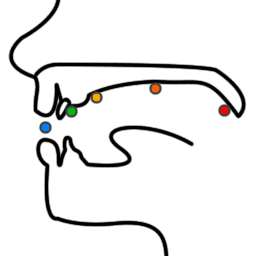Sanskrit for novices
This lesson will give you a basic feeling for what Sanskrit is like, so that you can understand some of questions that the Ashtadhyayi aims to answer. This lesson also contains various technical terms that are used to describe and classify Sanskrit sounds and words. We recommend keeping this page open so you can refer to it as needed.
The alphabet
The details of pronunciation are part of śikṣā (phonetics), not vyākaraṇa. But vyākaraṇa assumes a basic knowledge of Sanskrit phonetics, so we will try to give a sense of it here.
Sanskrit is written phonetically. Each sound has one symbol, and each symbol corresponds to one sound. The sounds below are provided in both the usual Devanagari script (संस्कृतम्) and in romanized Sanskrit (saṃskṛtam). All Devanagari in our lessons will be displayed next to its romanized version.
First are the vowels. Nine are called simple vowels:
- अ
a - आ
ā - इ
i - ई
ī - उ
u - ऊ
ū
- ऋ
ṛ - ॠ
ṝ - ऌ
ḷ
And four are called compound vowels, since they are made from combinations of the simple vowels:
- ए
e - ऐ
ai - ओ
o - औ
au
Of the vowels, five (a, i, u, ṛ, ḷ) are called short. The others are called long and are pronounced for twice the duration of the short vowels.
Next are two special sounds that we can ignore for now:
- अं
aṃ - अः
aḥ
Then come the stop and nasal consonants, which are pronounced by obstructing the flow of air through the mouth:
- क
ka - ख
kha - ग
ga - घ
gha - ङ
ṅa
- च
ca - छ
cha - ज
ja - झ
jha - ञ
ña
- ट
ṭa - ठ
ṭha - ड
ḍa - ढ
ḍha - ण
ṇa
- त
ta - थ
tha - द
da - ध
dha - न
na
- प
pa - फ
pha - ब
ba - भ
bha - म
ma
This is a grid with 5 rows and 5 columns. The first two columns (ka, kha) are unvoiced sounds, and the rest are voiced.
Next are the semivowels, which have a close relationship to the vowel sounds:
- य
ya - र
ra - ल
la - व
va
And the sibilants:
- श
śa - ष
ṣa - स
sa - ह
ha
All of the sounds above are colored according to the main point of articulation they use in the mouth. You can see these points of articulation in the image below:

From right to left, these five points are:
the soft palate
the hard palate
the alveolar ridge
the base of the teeth
the lips
Given all of these sounds, we have the first question that the Ashtadhyayi aims to answer: which phonetic distinctions are relevant and important in grammar?
Sandhi
In every spoken language, native speakers make subconscious changes to their speech so that they can speak more quickly and fluently. For example, some native English speakers might drop the final “g” of words like “running” or ”drinking.” These kinds of changes are called sandhi.
Sanskrit sandhi changes are extensive, and they are almost always written down. These changes occur both within words and between words, and they depend not only on specific sounds but also on the semantics of different words and suffixes. This prompts another question: which sandhi changes apply in which contexts?
Inflection
Inflection is when we change part of a word to express a new meaning. English uses inflection in a limited way: we have one cat but two cats. Or perhaps you ate yesterday but will eat today.
Sanskrit uses inflection much more extensively:
नयसि नीयेरन् नेष्यताम् निनीषन्तः
nayasi
You lead
nīyeran
They might be led.
neṣyatām
of those about to lead
ninīṣantaḥ
those who want to lead
and in much more elaborate patterns, with multiple sandhi changes:
लभे रुणध्मि
labhe
I obtain.
ruṇadhmi
I obstruct.
This raises the vital question: Which inflectional patterns apply in which contexts, and with what semantics?
Sentences
Because Sanskrit words are highly inflected, Sanskrit does not usually depend on a specific word order. For example, the two sentences below have the same semantics:
रामो रावणं हन्ति रावणं रामो हन्ति
rāmo rāvaṇaṃ hanti
Rama kills Ravana.
rāvaṇaṃ rāmo hanti
Rama kills Ravana.
Rather than word order, the Ashtadhyayi focuses on a more general question: how do words with different semantics combine to express sentence-level semantics?
The human constraint
Finally, we should remember that the Ashtadhyayi is part of a culture that values oral tradition and memorization. So another important question it tries to address is a pragmatic one: how can this system be compressed to the smallest possible form, so that it is easy to memorize and easy to recall?